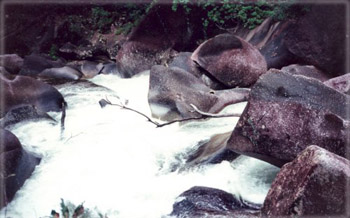 In 1972, Section 404 of the Clean Water Act established a program to regulate the discharge of dredged or fill material into waters of the United States. The Rivers and Harbors Act of 1899 defined navigable waters of the United States as “those waters that are subject to the ebb and flow of the tides and/or are presently used, or have been used in the past, or maybe susceptible to use to transport interstate or foreign commerce." The Clean Water Act built on this definition and defined waters of the United States to include tributaries to navigable waters, interstate wetlands, wetlands which could affect interstate or foreign commerce, and wetlands adjacent to other waters of the United States. In 1972, Section 404 of the Clean Water Act established a program to regulate the discharge of dredged or fill material into waters of the United States. The Rivers and Harbors Act of 1899 defined navigable waters of the United States as “those waters that are subject to the ebb and flow of the tides and/or are presently used, or have been used in the past, or maybe susceptible to use to transport interstate or foreign commerce." The Clean Water Act built on this definition and defined waters of the United States to include tributaries to navigable waters, interstate wetlands, wetlands which could affect interstate or foreign commerce, and wetlands adjacent to other waters of the United States.
The program is jointly administered by the U.S. Army Corps of Engineers and the Environmental Protection Agency. The Corps is responsible for the day-to-day administration and permit review and EPA provides program oversight. The fundamental rationale of the program is that no discharge of dredged or fill material should be permitted if there is a practicable alternative that would be less damaging to our aquatic resources or if significant degradation would occur to the nation’s waters. Permit review and issuance follows a sequence process that encourages avoidance of impacts, followed by minimizing impacts and, finally, requiring mitigation for unavoidable impacts to the aquatic environment. This sequence is described in the guidelines at Section 404(b)(1) of the Clean Water Act.The Fish and Wildlife Service plays an important advisory role in this process. Our mission is working with others to protect, conserve, and enhance fish, wildlife and plants, and their habitats, for the continuing benefit of the American people. Wetlands are vital for sustaining fish and wildlife populations in the United States. They provide important feeding, breeding, and migration habitat for a number of species. This includes 50 percent of our migratory bird species and over 30 percent of plants and animals listed under the Endangered Species Act. Our mission is authorized and accomplished via our various authorities, including: the Fish and Wildlife Coordination Act, Fish and Wildlife Act of 1956, Food Security Act, Anadromous Fish Conservation Act, Migratory Bird Treaty Act, and Endangered Species Act.
Links
|
|